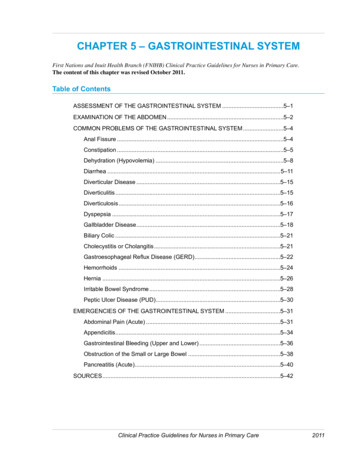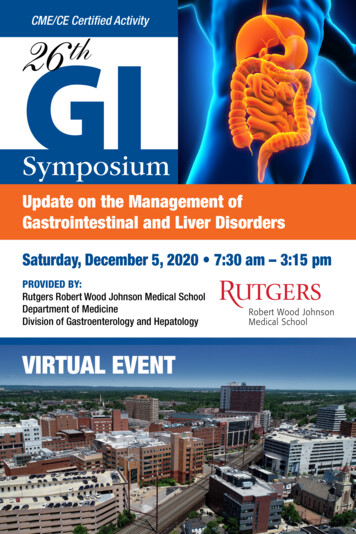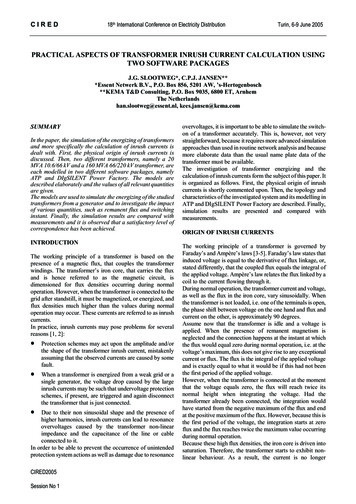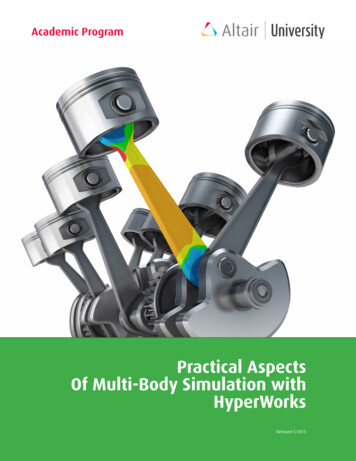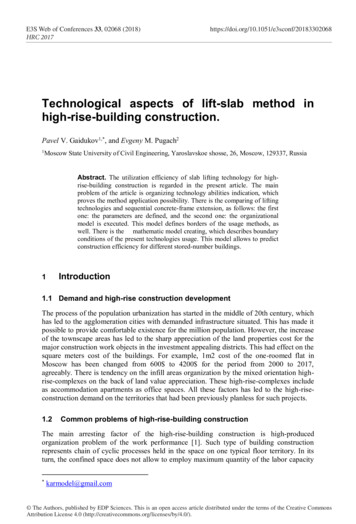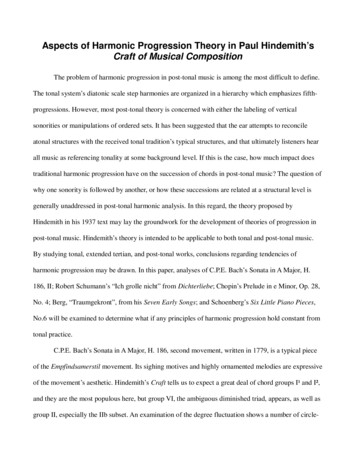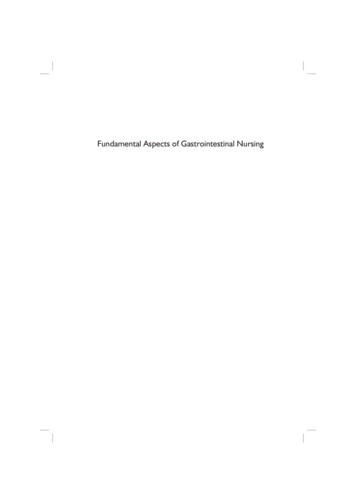
Transcription
Fundamental Aspects of Gastrointestinal Nursing
NoteHealth and social care practice and knowledge are constantly changing anddeveloping as new research and treatments, changes in procedures, drugs andequipment become available.The authors, editor and publishers have, as far as is possible, taken care to confirmthat the information complies with the latest standards of practice and legislation.
Fundamental Aspects ofGastrointestinal Nursingedited byCarol L. Cox, Martin J. Steggalland Alison M. Coutts
Quay Books Division, MA Healthcare Ltd, St Jude’s Church, Dulwich Road, LondonSE24 0PBBritish Library Cataloguing-in-Publication DataA catalogue record is available for this book MA Healthcare Limited 2012ISBN-10: 1 85642 426 XISBN-13: 978 1 85642 426 4All rights reserved. No part of this publication may be reproduced, stored in a retrieval systemor transmitted in any form or by any means, electronic, mechanical, photocopying, recording orotherwise, without prior permission from the publishersPrinted by Mimeo, Huntingdon, Cambridgeshire
ContentsForeword by Theresa PorrettPrefaceContributorsChapter 1Introduction to the fundamental aspects ofgastrointestinal nursingCarol L. CoxChapter 2Anatomy and physiology of the gastrointestinal systemMartin Steggallviiixxi19Chapter 3NutritionAlison Coutts29Chapter 4Upper gastrointestinal complaintsWarren Chapman43Chapter 5Lower gastrointestinal complaintsCarol C. Cox59Chapter 6Tumours of the gastrointestinal tractDaniel Apau87v
ContentsChapter 7Malabsorption syndromesAlison Coutts107Chapter 8Intestinal complications of inflammatory bowel disease 117Julia WilliamsChapter 9Gastrointestinal imaging studiesJennifer Edie129Chapter 10Other diseasesWarren Chapman141Index157vi
This book is dedicated to Karen Elizabeth Knowlton, loving daughterand nurse who died on 20 April 2010 of acute pancreatitis, intra-abdominalabscesses and sepsis.
ForewordSince the advent of stoma nursing over 30 years ago, the development of nursingroles in gastroenterology clinical practice has widened significantly. This bookexplores the fundamental aspects of nursing patients who have gastrointestinalproblems. It is targeted primarily toward the student nurse or the nurse who ispreparing to work for the first time in a clinical area that manages gastrointestinalproblems. Clinical nursing practice is advancing, and a key element of skilledclinical practice is advocacy. Today’s nurses can now broaden their ability toadvocate for the needs of patients with gastrointestinal problems: essential skills,given the stigma and embarrassment that surround many of these problems.Each chapter provides the nurse with a clear description of the gastrointestinaldisease, the assessment and diagnostic pathway of the patient and a practical andclear delineation of the clinical skills and knowledge required to care holisticallyfor the patient. The book brings together an impressive group of academics andclinical practitioners, all experts in their field, to create a practical and relevanttext. After reading this book nurses will have advanced their knowledge in thisfield of nursing and will be assured that the care they provide is appropriatelyprioritised and built around the needs of the patient. This is the first book of itskind – it fills an educational gap and is sure to inform, inspire and motivate thefuture generation of clinical nurse specialists in gastroenterology.Theresa Porrett, PhD, MSc, RNGastrointestinal Nurse Consultant, Homerton University Hospital NHSFoundation Trust, LondonHonorary Reader, Department of Applied Biological Sciences, CityUniversity, Londonix
PrefaceThis text has been written for the student nurse and aspiring gastrointestinalnurse who wishes to launch their career in gastrointestinal practice as well asfor nurses who want to inform their thinking about gastrointestinal disorders andtheir nursing management. Throughout, perspectives on practice emerge that willpromote the formation of new thinking in relation to the fundamental aspects ofgastrointestinal nursing. In each chapter aspects of practice are presented to assistin the development, implementation and evaluation of gastrointestinal nursingpractice.In Chapter 1 the foundation for considering nursing care associated witha variety of gastrointestinal disorders is described. It reflects on the contextin which care is provided and the professional role of the nurse. It provides aviewpoint on accountability and managing risk associated with the complexitiesof gastrointestinal nursing and concludes by acknowledging that gastrointestinalnursing does not exist in isolation. It exists within an environment in which it isintegral to, and forms an essential part of, the multidisciplinary team responsiblefor the care of patients who have gastrointestinal disease and disorders.Chapter 2 articulates the anatomy and physiology of the gastrointestinal tract.It provides background knowledge for the chapters that follow so that the aspiringnurse as well as the practising nurse or allied health professional can understandthe complexities of diseases and disorders within the practice of gastrointestinalcare.Chapter 3 discusses nutrition, including the components of a healthy diet.It indicates that constituents such as proteins, lipids, carbohydrates, mineralsand vitamins are essential elements that should be balanced in a healthy diet.Malnutrition, dehydration, screening and assessment of nutritional status, foodpoisoning and its causes and prevention are discussed. Consideration is also givento the issues of food poverty, food security and the politics of food.Chapter 4 relates to complaints of the upper gastrointestinal tract. Conditionsof the oesophagus, stomach and duodenum, and cancer of the upper gastrointestinaltract are discussed. At the conclusion of the chapter knowledge of the variousupper gastrointestinal complaints will be improved. By reading the chapter,xi
Prefacestudent and practising nurses will have a greater understanding of the managementoptions available and the diagnostic tests that patients with upper gastrointestinalsymptoms may undergo. Finally, the lifestyle changes that some patients withupper gastrointestinal complaints may find beneficial are presented.Chapter 5 involves consideration of constipation, diarrhoea, wind and bloating,rectal pain and bleeding, mesenteric ischaemia, perforation, appendicitis, occultgastrointestinal (GI) bleeding, intestinal obstruction, intra-abdominal abscessesand pancreatitis. Each condition is defined in association with its epidemiologyand pathophysiology. Its assessment, diagnosis and associated care planning withnursing interventions are also discussed. At the conclusion of the chapter, keypoints are presented to assist the student or practising nurse in caring for patientswith lower GI complaints.Chapter 6 reflects on tumours of the gastrointestinal tract. The epidemiology,pathophysiology, aetiology, signs and symptoms, diagnosis and managementof gastrointestinal tumours provide the background for the provision of nursingcare. The nursing process, including diagnosis and care planning as well asimplementation of various interventions, are discussed to assist the student andpractising nurse in the provision of care to patients with gastrointestinal tumours.Chapter 7 addresses malabsorption syndrome. It is indicated that malabsorptionis not a diagnosis but a range of syndromes that occur when nutrients are notabsorbed from within the gastrointestinal tract. Pathophysiology, includinginflammation and infection, structural abnormalities, insufficient digestive agentsand impaired transport, forms the foundation knowledge for appropriate nursingcare. Assessment, diagnosis, care planning and nursing interventions conclude thechapter to assist the student or practising nurse or allied health professional in theprovision of care.Chapter 8 explores the chronic disorder of inflammatory bowel disease, whichtypically presents in early adulthood. It provides a fundamental understanding ofinflammatory bowel disease that will enable the student or practising nurse toassess, plan and deliver immediate care for this patient group. It also focuses onthe long-term support required for the person with a chronic debilitating illness.Chapter 9 considers a range of procedures used in imaging of the gastrointestinaltract. It gives a brief description of each procedure, along with patient preparationand aftercare. It is noted that the gastrointestinal tract can be difficult to imagewell, as it does not show up clearly on images. Various factors considering thisconundrum are discussed. The use of contrast agents and good bowel preparationare described to show how much of this problem can be overcome.xii
PrefaceChapter 10 explores a range of conditions that cannot be neatly categorisedas arising within a part of the gastrointestinal tract, but for which they havesignificant implications. Diseases addressed include coeliac disease, anorexianervosa, reactive arthritis, gastrointestinal anthrax and trichinosis. Epidemiology,pathophysiology, assessment, diagnosis and treatment, including the provision ofnursing care, are described in association with each disease.The authors who have contributed to this book are experts in the field ofgastrointestinal nursing practice. They have written each chapter with the intentionof providing knowledge that will promote skill development in gastrointestinalnursing practice. We think you will enjoy reading this text.Carol L. Cox, Martin J. Steggall and Alison M. CouttsAcknowledgementSpecial thanks are expressed to Mariann Baulf for her advisory capacity inChapter 10: Other diseases.xiii
ContributorsDaniel Apau, MSc, BSc, ENB 100, RGNLecturer, Advanced Practice, School of Health Sciences, City University London(Chapter 6)Warren Chapman, MSc Advanced Practice (Nursing), RNJAG accredited upper and lower GI EndoscopistNurse Consultant, Endoscopy Unit, City Hospital, Sandwell and West BirminghamHospitals NHS Trust, Birmingham(Chapters 4 and 10)Alison M. Coutts, MSc, BSc, PGCEA, RGNSenior Lecturer Applied Biological Sciences, School of Health Sciences, CityUniversity London(Chapters 3 and 7)Carol L. Cox, PhD, MSc, MA Ed, PG Dip Ed, BSc (Hons), RN, FHEAProfessor of Nursing, Advanced Clinical Practice, Department of AppliedBiological Sciences, School of Health Sciences, City University London(Chapters 1 and 5)Jennifer C. Edie, MEd, TDCR, DMUSenior Lecturer, Radiography, School of Health Sciences, City University London(Chapter 9)Martin J. Steggall, PhD, MSc, BSc (Hons), RN (Adult), FHEAAssociate Dean, Pre-registration Undergraduate Nursing and Midwifery, Schoolof Health Sciences, City University London(Chapter 2)xv
ContributorsJulia Williams, MEd, BSc (Hons), Dip D/N, RGNSenior Lecturer Burdett Institute of Gastrointestinal Nursing, Burdett Institute ofGastrointestinal Nursing with King’s College and St. Mark’s Hospital, Harrow,London(Chapter 8)xvi
CHAPTER 1Introduction to thefundamental aspects ofgastrointestinal nursingCarol L. CoxIntroductionThe practice of gastrointestinal nursing is both a science and an art. It requiresspecialised knowledge and skills to provide holistic care to patients and toensure positive patient experiences in both health and illness. Practice as agastrointestinal nurse occurs in a variety of environments. Gastrointestinal nursesmay find themselves practising in an outpatient clinic, ward or palliative careunit as well as working in patients’ homes as nurse specialists. The purpose ofthis book is to articulate the fundamental aspects of nursing patients who havegastrointestinal disorders. It is targeted primarily toward the student nurse or nursewho is preparing to work in a clinical environment that manages gastrointestinaldisorders for the first time. However, it also has specific relevance for practicenurses working in general practice surgeries and district and health visiting nurseswho need to recognise gastrointestinal disorders when managing their patientcaseloads. It also has relevance for allied health professionals practising withinprimary and secondary care who wish to gain fundamental knowledge aboutgastrointestinal disorders.Providing holistic care to patients with gastrointestinal disorders requires anunderstanding of basic human needs and the ability to grasp patients’ understandingof their health and illness within the context of their cultural background. Nursingtheories and models of care and models like the Health Belief Model (Becker, 1974)are essential knowledge that impart a basis and rationale for practice. They alsorender a focus for nursing care. The patient’s physical, intellectual, psychosocial,cultural, ethnic, spiritual and environmental factors must all be taken into account1
Fundamental aspects of gastrointestinal nursingwhen promoting wellness, preventing illness and fostering the development ofcoping mechanisms (Watson, 1999, 2008). In addition, an understanding of theattitudes and values that influence human behaviour and the ethical dimensionsof nursing practice (Nursing and Midwifery Council (NMC), 2008) are essentialcomponents of the nurse’s toolkit in the management of patient care.ActivityReflect on the models of care that you have learned about as a student atuniversity. Which ones have influenced your world view about practice?This chapter establishes the foundation for considering nursing careassociated with a variety of gastrointestinal disorders. It considers the contextin which care is provided and the professional role of the nurse. It provides aviewpoint on accountability and managing risk associated with the complexitiesof gastrointestinal nursing and concludes by acknowledging that gastrointestinalnursing does not exist in isolation. Gastrointestinal nursing has broadened withinall areas of its specialism and exists within an environment in which it is integraland forms an esse
and pancreatitis. Each condition is defi ned in association with its epidemiology and pathophysiology. Its assessment, diagnosis and associated care planning with nursing interventions are also discussed. At the conclusion of the chapter, key points are presented
